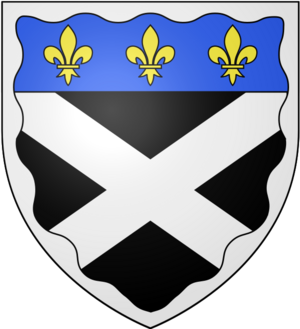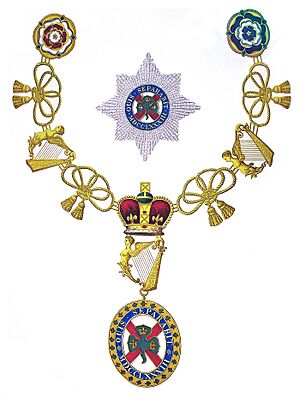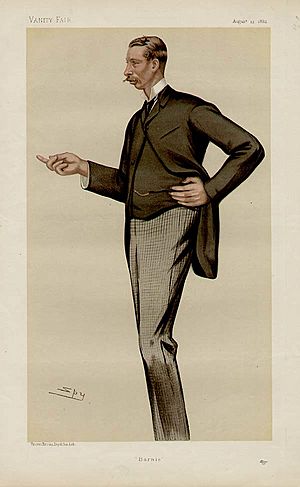Bernard FitzPatrick, 2nd Baron Castletown facts for kids
Bernard Edward Barnaby FitzPatrick, 2nd Baron Castletown (born July 29, 1848 – died May 29, 1937) was an important person from Ireland who was both a soldier and a politician. He was known as an Anglo-Irish person, meaning he had British and Irish heritage. He was a member of the Conservative Party and served in the UK Parliament.
Contents
Bernard FitzPatrick's Life Story
Early Life and Education
Bernard FitzPatrick was the son of John FitzPatrick, 1st Baron Castletown. His mother was Augusta Mary Douglas. He went to two famous schools: Eton and Brasenose College, Oxford, which is part of Oxford University.
In 1876, he was chosen as the High Sheriff of Queen's County. This was an important local role, like a chief law enforcement officer for the county. From 1880 to 1883, he was a Member of Parliament for an area called Portarlington. This meant he helped make laws for the country. In 1883, his father passed away, and Bernard became the 2nd Baron Castletown. This gave him a seat in the House of Lords, which is the upper house of the UK Parliament.
Military Career and Adventures
Bernard FitzPatrick was also a brave soldier. He served in the Life Guards, a special part of the British Army. He fought in Egypt in 1882. After leaving active service, he joined the Reserve of Officers in 1886. This meant he could be called back to duty if needed.
He continued to serve as a volunteer officer until 1900. He became a major in 1896 and later a lieutenant colonel. He commanded the 4th Battalion of the Leinster Regiment, which was a Militia (a group of citizen soldiers). He was the first to give them bagpipers, which are traditional Irish musical instruments.
In 1900, he went to South Africa to help during the Second Boer War. For his service there, he was given a special award called the Companion of the Order of St Michael and St George (CMG). In 1902, he also went on a special trip to Morocco to help improve relations for Britain.
Interests and Leadership Roles
Bernard FitzPatrick was interested in many things. In 1903, he became an honorary Vice President of the Irish Literary Society of New York, along with famous people like Theodore Roosevelt. He also suggested a new way of farming in Ireland, based on old Irish traditions. From 1906 to 1910, he was the Chancellor of the Royal University of Ireland, which was a very important role in education.
The Mystery of the Irish Crown Jewels
In 1907, something very unusual happened: the Irish Crown Jewels went missing! This happened just before King Edward VII and Queen Alexandra were supposed to visit Ireland. Bernard FitzPatrick was going to be given a special honor, becoming a Knight of the Order of St Patrick, during this visit.
The theft made the King very upset, and the special ceremony for Bernard was cancelled. The jewels were never found. However, Bernard FitzPatrick still received his honor the next year, in 1908. He became a Knight of the Order of St Patrick and joined the Irish Privy Council, another important group. His special banner, showing his connection to the Order, can still be seen in St. Patrick's Hall at Dublin Castle.
Family Life and Legacy
Lord Castletown married Emily Ursula Clare St Leger in 1874. They did not have any children. Lady Castletown joined her husband in South Africa during the Boer War.
Bernard FitzPatrick passed away on May 29, 1937, at the age of 87. Since he had no children, his title as Baron Castletown ended when he died.
He was very passionate about Celtic heritage. He helped start the Celtic Association in Dublin in 1900. This group worked to protect the languages, literature, music, clothing, and customs of Celtic people. Bernard was the president of this association. The Celtic Association organized several big meetings called Pan-Celtic Congresses in different cities like Dublin, Caernarfon, and Edinburgh. These meetings brought together people from Ireland, Scotland, Wales, Brittany, and the Isle of Man, and later Cornwall, to celebrate their shared Celtic culture.





